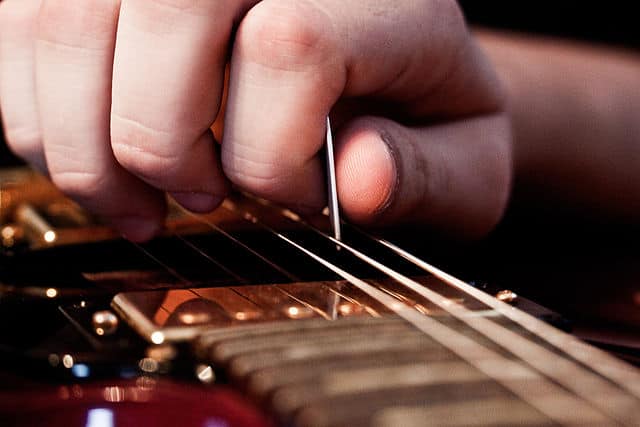Imagine you learn a new song on your guitar, you run to your friend’s house to show your progress and how you perform the song.
Your friend listens to you attentively but when you finish playing says “Nice dude! Good job, have you ever tried to play that section with alternate picking instead of down picking?”
At that moment you may feel confused but don’t worry, is more usual than you think.
The guitar is such a complex instrument and there are a lot of things to learn about it.
Alternate and down-picking are quite different techniques that every guitarist should master. Picking every note downwards creates a more aggressive sound and helps separate every note rhythmically. Alternate picking, on the other hand, generates a more fluid sound and allows for playing faster licks.
A huge debate has come about this topic, some players claim that one is more advanced than the other while some other musicians believe exactly the opposite but I will help you get through this overwhelming situation.
In this article, I will explain the main differences between alternate and down picking, every feature related to them, and I will also give you some tips to incorporate these useful methods into your overall playing.
What is alternate picking?
Alternate picking is a common guitar technique which consists of giving downward and upward strokes with your picking hand.
The interesting thing about this playing method is that you alternate movements to economize energy and to play faster lines.
What is down picking?
Contrarily to alternate picking, we have another well-known technique called down picking.
This method involves using only downstrokes with your picking hand, some players defined this technique as “one-half” of alternate picking.
Is alternate picking faster?
Alternate picking employs up and down picking movements.
The word “alternate” intends that after every downstroke of the pick, there must be an upstroke as well.
For beginners could be a tough technique to master but it would be great to learn tremolo picking.
What is more, this method makes most rhythms easier and faster to play.
This occurs because by applying this approach you economize movements, energy, and the pick is in constant contact with the strings.
Furthermore, alternate picking is in fact faster than its counterpart.
Why would anyone prefer down picking over alternate picking?
This technique can be used for playing lines that are not that dense with notes but the interesting thing about down picking is the personality that gives to the sound.
Down picking has a more aggressive, sharp sound which is wonderful for rhythm sections.
In addition, this approach gives the overall to many genres, mainly metal.
A perfect example of this aspect is the guitar player James Hetfield, leader of the extremely famous band Metallica.
Hetfield is well-known for using this technique and when he plays the trashy sound is really noticeable.
James has mastered this technique so he is able to play amazingly fast just by using downstrokes which give a truly personal sound.
Is alternate picking hard?
As with many playing approaches, alternate picking is usually difficult for beginners but is not something unreachable.
Although at first is hard, once you get the hang of it, it becomes second nature.
As long as it takes, practice to master the technique.
In the beginning, don’t worry about speed, just focus on timing and rhythm.
You should start practicing slowly making sure that you are alternating pick movements.
The rest will come up and after some time it will be something you do unconsciously.
Is down picking hard?
Down picking by itself is not a hard technique, as its name suggests you only need to move your picking hand in downward motion against one or more strings.
Nevertheless, the really interesting, tough thing is mastering this method.
Although it might be the first technique first learners acquire, playing at a fast tempo could make you throw the towel amazingly quickly.
To master down picking, you need to get along with the metronome plus a good endurance to not get tired after two minutes of playing.
As I mentioned before, James Hetfield is the synonym of down picking, many players struggle to play beastly fast lines such as Master of Puppets or Whiplash the way he does it.
Other popular eminencies of down picking are Joey Ramone from The Ramones and David Mustaine from Megadeath.
Advantages of alternate picking
Having defined this technique, it is time to discuss its benefits.
The first noticeable point in favor is that you can play at a higher speed accurately.
By playing alternate picking you can take profit from each picking hand movement, that’s why is a good approach to develop playing speed.
In addition, it helps a lot to master other techniques such as tremolo picking.
Another remarkable aspect is that this method sounds more fluid and it feels like a more natural way of playing.
What I mean to say is that as you are constantly moving down and up you can get a solid stroke in each string plus a better control of time.
Last but not least, alternate picking can be acquired in a few months of practice.
Once is ingrained, you never think about it, you just play and your hands never stop moving.
Drawbacks of alternate picking
On the other hand, there are some disadvantages of alternate picking.
Although it is a fine and fluid way to play guitar, it doesn’t sound kind of strong or aggressive.
Alternate picking is not a good option to play sections that require strength or sharpness in the sound.
It is a perfect smoother approach but it doesn’t have that punch sometimes is needed.
What is more, the tone is also affected distinctively.
Every stroke will sound the same and this is useful on counted occasions.
What I mean is each note will have the same sound which will give you a monotonous tone.
That is what every player wants to avoid, sounding boring.
Finally, this approach will sometimes limit your playing.
Alternate picking will work great on some occasions but, as every downstroke is followed by an upstroke and vice-versa, you will get a poor movement radio.
Advantages of down picking
Now is the time to debate about down picking and its advantages.
This picking style has a characteristic tone.
As you play only stroking the strings downwards, you produce a harmonious tone in your playing.
In addition, makes your tone more consistent and some riffs sound way better applying this technique.
Another relevant feature is the feel that down picking produces.
As it is a violent way to play, is excellent to show the spirit of the songs, it is said that it resembles an angry attitude and it gives more punch and attack to the piece.
Another important claim is how well down picking works for rhythm sections.
As you need a constant tone this method suits perfectly for those rhythms players, especially if they mainly play chords on the thicker strings.
Drawbacks of down picking
Contrarily, we need to mention the possible disadvantages of down picking.
Firstly, although it seems like an easy playing method, it is really complicated to master.
Playing at high speeds would be a tough challenge by using down picking.
Your wrist will have to get used to strumming fast, you will require long-lasting hours of practice.
Since it is hard, it may feel like a restriction to some players, even experimented ones.
Some guitarists avoid this approach just because they feel frustrated or are not comfortable applying it.
Summary
To sum up, I suggest you practice and develop every technique previously discussed, any tool you can acquire is great for your personal growth as a musician.
Alternate and down picking are amazing approaches used and applied by a lot of professional players worldwide.
You need to be acquainted with each of them and their common uses.
For fast, fluid lines is better to use alternate picking whereas for slower, aggressive lines you’d rather use down picking.
As regards difficulty, alternate picking is harder to learn but you can master it quite fast.
However, down-picking will be easier at the beginning but mastering this technique will require more time than expected.
Alternate picking is commonly used in any genre, is good for solos, melodies, or even fast riffs and licks.
On the other side, down picking is mostly used for rhythm sections, palm muting, and riffs too but it’s relegated to some genres such as metal, hard rock, or country.
The following table summarizes roughly my opinion on the matter:
| Technique | Alternate picking | Down picking |
| Speed | Faster | Slower |
| Tone | More fluid | More aggressive |
| Difficulty | Harder to learn, easier to master | Easier to learn, harder to master |
| Good for | Solos, melody, fast riffs, or licks | Rhythm, palm muting, riffs |
| Genres | Any genre | Metal, hard rock, rock, blues, country |
Final conclusion
What can be said that was not mentioned before?
I strongly believe that music has no rules.
You are the one who decides which method to incorporate into your playing but let me tell you that there aren’t right or wrong paths.
I recommend you try to domine each technique, alternate and down picking.
Then, use them in the way you prefer, combine them, and try to add new fresh flavors and hues to your style.
Finally, if you enjoyed this article, you might also find useful the following one:

Hello there, my name is Ramiro and I’ve been playing guitar for almost 20 years. I’m obsessed with everything gear-related and I thought it might be worth sharing it. From guitars, pedals, amps, and synths to studio gear and production tips, I hope you find what I post here useful, and I’ll try my best to keep it entertaining also.





